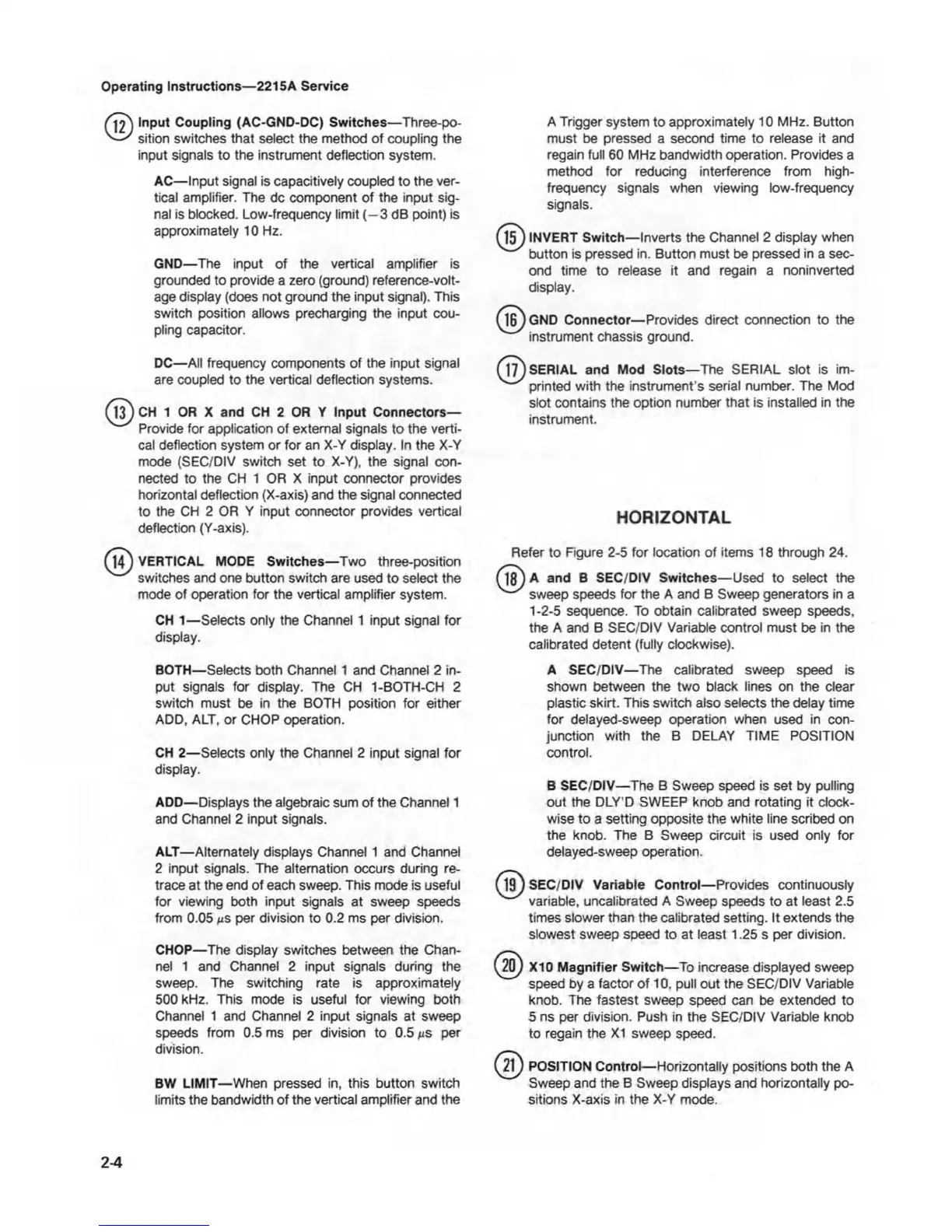Operating Instructions— 2215A Service
©
Input Coupling (AC-GND-DC) Switches— Three-po
sition switches that select the method of coupling the
input signals to the instrument deflection system.
AC— Input signal is capacitively coupled to the ver
tical amplifier. The dc component of the input sig
nal is blocked. Low-frequency limit (—3 dB point) is
approximately 10 Hz.
GND—The input of the vertical amplifier is
grounded to provide a zero (ground) reference-volt
age display (does not ground the input signal). This
switch position allows precharging the input cou
pling capacitor.
DC—All frequency components of the input signal
are coupled to the vertical deflection systems.
(j3 ) CH 1 OR X and CH 2 OR Y Input Connectors—
Provide for application of external signals to the verti
cal deflection system or for an X-Y display. In the X-Y
mode (SEC/DIV switch set to X-Y), the signal con
nected to the CH 1 OR X input connector provides
horizontal deflection (X-axis) and the signal connected
to the CH 2 OR Y input connector provides vertical
deflection (Y-axis).
M 4) VERTICAL MODE Switches—Two three-position
v— switches and one button switch are used to select the
mode of operation for the vertical amplifier system.
CH 1—Selects only the Channel 1 input signal for
display.
BOTH—Selects both Channel 1 and Channel 2 in
put signals for display. The CH 1-BOTH-CH 2
switch must be in the BOTH position for either
ADD, ALT, or CHOP operation.
CH 2—Selects only the Channel 2 input signal for
display.
ADD— Displays the algebraic sum of the Channel 1
and Channel 2 input signals.
ALT—Alternately displays Channel 1 and Channel
2 input signals. The alternation occurs during re
trace at the end of each sweep. This mode is useful
for viewing both input signals at sweep speeds
from 0.05 ms per division to 0.2 ms per division.
CHOP—The display switches between the Chan
nel 1 and Channel 2 input signals during the
sweep. The switching rate is approximately
500 kHz. This mode is useful for viewing both
Channel 1 and Channel 2 input signals at sweep
speeds from 0.5 ms per division to 0.5
ns
per
division.
BW LIMIT—When pressed in, this button switch
limits the bandwidth of the vertical amplifier and the
A Trigger system to approximately 10 MHz. Button
must be pressed a second time to release it and
regain full 60 MHz bandwidth operation. Provides a
method for reducing interference from high-
frequency signals when viewing low-frequency
signals.
U 5 j INVERT Switch— Inverts the Channel 2 display when
button is pressed in. Button must be pressed in a sec
ond time to release it and regain a noninverted
display.
U6JGND Connector—Provides direct connection to the
instrument chassis ground.
( j? ) SERIAL and Mod Slots—The SERIAL slot is im-
printed with the instrument's serial number. The Mod
slot contains the option number that is installed in the
instrument.
HORIZONTAL
Refer to Figure 2-5 for location of items 18 through 24.
(j8 ) A and B SEC/DIV Switches— Used to select the
v
^
sweep speeds for the A and B Sweep generators in a
1-2-5 sequence. To obtain calibrated sweep speeds,
the A and B SEC/DIV Variable control must be in the
calibrated detent (fully clockwise).
A SEC/DIV—The calibrated sweep speed is
shown between the two black lines on the clear
plastic skirt. This switch also selects the delay time
for delayed-sweep operation when used in con
junction with the B DELAY TIME POSITION
control.
B SEC/DIV—The B Sweep speed is set by pulling
out the DLY'D SWEEP knob and rotating it clock
wise to a setting opposite the white line scribed on
the knob. The B Sweep circuit is used only for
delayed-sweep operation.
M{U SEC/DIV Variable Control— Provides continuously
variable, uncalibrated A Sweep speeds to at least 2.5
times slower than the calibrated setting. It extends the
slowest sweep speed to at least 1.25 s per division.
(20) X10 Magnifier Switch—To increase displayed sweep
speed by a factor of 10, pull out the SEC/DIV Variable
knob. The fastest sweep speed can be extended to
5 ns per division. Push in the SEC/DIV Variable knob
to regain the XI sweep speed.
POSITION Control—Horizontally positions both the A
Sweep and the B Sweep displays and horizontally po
sitions X-axis in the X-Y mode.
2-4

